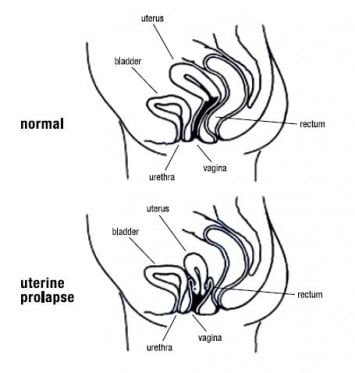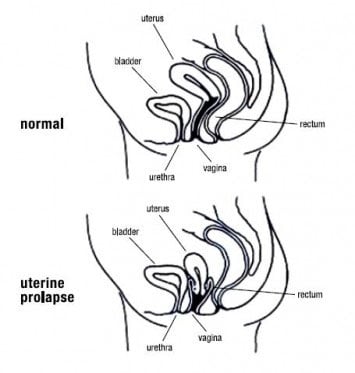What is a vaginal (or pelvic organ) prolapse?Your pelvic organs are your bladder, uterus (womb), large bowel and rectum (back passage). These organs are held in place by support tissues called ‘fascia’ and ‘ligaments’. These support tissues help to join your pelvic organs to the bony side walls of the pelvis. They hold the organs up inside your pelvis. These support tissues can be torn or stretched. Your pelvic floor muscles support your pelvic organs from below. If your pelvic floor muscles are also weak, they may not give your pelvic organs proper support. Without strong support, pelvic organs may bulge down into the vagina (birth canal). |
膣(または骨盤器官)脱出とは何ですか?骨盤内器官とは、膀胱、子宮、大腸、および肛門のことです。これらの器官は、「筋膜」および「靱帯」と呼ばれる組織によって支えられています。これらの支持組織は、骨盤の骨の多い側面に骨盤内器官が結合できるように支え、骨盤内にこれらの器官が収まるようにします。これらの支持組織は、裂けたり、伸びたりすることがあります。骨盤底筋は、下から骨盤内器官を支えますが、骨盤底筋が弱い場合、骨盤内器官を十分に支えることができません。しっかり支えられていないと、骨盤内器官は膣に向けて下がってしまいます。 |
What are the signs of prolapse?There are a few signs that you may have a prolapse. These depend on the type of prolapse and how much pelvic organ support has been lost. Early on, you may not know you have a prolapse. Your doctor or nurse might see your prolapse when you have your routine Pap test. When a prolapse sags down, you may notice things such as:
These signs may be worse at the end of the day and you may feel better after lying down. If the prolapse bulges right outside your body, you may feel sore and bleed as it rubs on your underwear. |
骨盤臓器脱の兆候は?骨盤臓器脱を示す兆候はいくつかあります。骨盤臓器脱のタイプと、骨盤内器官へのサポートがどのくらい失われたかによって異なります。最初は、骨盤臓器脱であることに気づかないことがあります。子宮頸がん検査を定期的に受けるときに、医師または看護師が骨盤臓器脱を発見することもあります。 骨盤臓器脱が下がる場合、次のことに気づく場合があります。
これらの兆候は夜には悪化し、横になると改善するように感じられます。骨盤臓器脱が体外に突出した場合、下着に当たって出血することがあります。 |
What causes prolapse?The pelvic organs are held up inside the pelvis by strong healthy support tissues. The pelvic floor muscles also provide support from below providing a firm muscle sling. Working together they keep the bladder, uterus and bowel in place within the pelvis. Prolapse can happen if the support tissues or the pelvic floor muscles are damaged or weak. Childbirth is the main cause of prolapse. The baby can stretch or tear the support tissues on its way down the birth canal. The baby can also stretch and tear the pelvic floor muscles at birth. The more vaginal births you have, the more likely you are to have a prolapse. |
骨盤臓器脱の原因は?骨盤内器官は、健全な支持組織によって骨盤内で支えられています。骨盤底筋は下部からサポートを提供し、しっかりした筋肉索を提供します。連携して、膀胱、子宮、および腸を骨盤内の正しい位置に保ちます。骨盤臓器脱は、支持組織または骨盤底筋が損傷しているか、弱い場合に起こることがあります。 出産は、骨盤臓器脱の主要な原因です。赤ちゃんが産道を下がるときに、支持組織が伸びたり、裂けることがあります。出産時に骨盤底筋が伸びたり、裂けたりすることもあります。自然分娩をすればするほど、骨盤臓器脱になる可能性が高まります。 |
|
|
 |
|
There are other things that press down onto the pelvic organs and the pelvic floor muscles that can lead to prolapse:
|
それ以外にも、骨盤器官と骨盤底筋を押下げて、骨盤臓器脱を引き起こす原因となるのは、次のとおりです。
|
Types of prolapsePelvic organs may bulge into the vagina:
|
骨盤臓器脱の種類骨盤器官が膣内に突出する方法:
|
Who is likely to have a prolapse?Prolapse is common and tends to run in families. It is more likely after menopause. Being overweight puts extra load on the pelvic organ supports. Prolapse can happen in young women right after having a baby. Half of all women who have had a child have some level of pelvic organ prolapse. But across the lifespan only 1 in 5 women have symptoms that cause them to seek help. Prolapse can also happen in women who have not had a baby if they cough, strain on the toilet, or lift heavy loads. Even after surgery to mend prolapse, 1 in 3 women will prolapse again. Prolapse can also happen in women who have had their womb removed. This is called a hysterectomy. In a case like this, the top of the vagina (the vault) can prolapse. |
骨盤臓器脱になりやすい人は?骨盤臓器脱は頻繁に見られる問題で、遺伝する傾向があります。更年期後によく起こります。肥満の場合、骨盤底筋の支持組織に過度の負荷がかかります。 骨盤臓器脱は、出産直後の若い女性にも起こることがあります。出産経験のあるすべての女性の半数は、ある程度の骨盤臓器脱を経験します。ただし、一生を通じて外部の支援が必要となる症状が現れるのは、5人に1人のみです。 咳、排便時のいきみ、または重いものを持ち上げた場合に、出産経験がなくても骨盤臓器脱になることがあります。骨盤臓器脱の手術の後でも、3人に1人は骨盤臓器脱が再発します。 子宮を摘出した女性(子宮摘出)でも、骨盤臓器脱になることがあります。このようなケースでは、膣の上部に骨盤臓器脱が起こることがあります。 |
What can be done to help prevent prolapse?It is much better to prevent prolapse than try to fix it. You are more at risk if any women in your close family have had a prolapse. It is important for you to follow the advice given here. Prolapse is due to weak pelvic tissues and pelvic floor muscles. You need to keep your pelvic floor muscles strong no matter what your age. Pelvic floor muscles can be made stronger with proper training. See the brochure ‘Pelvic Floor Muscle Training for Women’. It is important to have your pelvic floor muscles checked by an expert. This might be a continence physiotherapist or a continence nurse advisor. These experts can help plan a pelvic floor muscle training program just for you. This can prevent prolapse. Pelvic floor muscle training can also help if you already have a prolapse. |
骨盤臓器脱を防ぐために何ができますか?骨盤臓器脱を治療するよりも、予防することが勧められます。家族に骨盤臓器脱を経験した人がいる場合、リスクが高くなります。必ず、以下のアドバイスに従ってください。 骨盤臓器脱は、骨盤の組織や骨盤底筋が弱いために起こります。そのため、年齢に関係なく、骨盤底筋を強く保つことが必要です。 骨盤底筋は、適切なトレーニングによって強化できます。パンフレット「女性のための骨盤底筋トレーニング」を参照してください。骨盤底筋を専門家にチェックしてもらうことが非常に重要です。これには失禁物理療法士、または失禁看護アドバイザーが含まれます。これらの専門家は、個別の骨盤底筋トレーニングプログラムを作成できます。それによって、骨盤臓器脱を防ぐことができます。骨盤臓器脱を既に経験されている場合でも骨盤底筋のトレーニングをすると改善することがあります。 |
What can be done to treat prolapse once it has happened?Prolapse can be dealt with simply or with surgery. This depends on the level of prolapse. The simple approach Prolapse can often be treated without surgery, mainly in the early stages when the prolapse is mild. The simple approach can mean:
The surgery approach Surgery can be done to repair the torn or stretched support tissues and ligaments. Surgery can be done through the tummy or vagina. Sometimes special mesh is placed into the front or the back vaginal wall. This is to make the vaginal wall stronger where it is weak or torn. The mesh helps form stronger tissues as the body heals and gives support where it is needed. After surgery To prevent the prolapse coming back again, make sure you:
|
骨盤臓器脱になってしまったら、治療のために何ができますか?骨盤臓器脱は簡単な方法、または手術によって治療できます。これは骨盤臓器脱のレベルによって異なります。 簡単なアプローチ 骨盤臓器脱が深刻ではない早期の段階では、手術せずに治療できます。簡単なアプローチとは:
手術 手術により、裂けた、または伸びた支持組織と靱帯を修復することができます。手術は、腹部または膣から実行できます。時によっては、膣の前部または後部の壁に特別なメッシュを配置することがあります。これは、膣の壁が弱まっている、または裂けているときに壁を強くすることが目的です。身体が回復し、必要な場所にサポートを提供するにつれ、メッシュが強い組織の形成を助けます。 手術後 骨盤臓器脱が再発しないように、以下のことを確認してください。
|
Seek helpYou are not alone. Poor bladder and bowel control can be cured or better managed with the right treatment. If you do nothing, it might get worse. Phone expert advisors on the National Continence Helpline for free:
1800 33 00 66 * (8am - 8pm Monday to Friday AEST) * Calls from mobile telephones are charged at applicable rates. To arrange for an interpreter through the Telephone Interpreter Service (TIS), phone 13 14 50 Monday to Friday and ask for the National Continence Helpline. Information in other languages is also available from continence.org.au/other-languages For more information:
* Calls from mobiles are charged at applicable rates. |
助けを求めるお悩みの方はあなただけではありません。排尿と排便のコントロールの問題は、適切な治療を受けることで回復または管理できます。そのままの状態では、悪化することがあります。 National Continence Help Line(全国失禁ヘルプライン)に電話すれば、無料で専門家による以下のアドバイスが受けられます。
1800 33 00 66 * (8am - 8pm 月曜〜金曜、東部標準時間) 電話通訳サービス(TIS)を通じて通訳を手配するには、月曜日から金曜日の間に13 14 50にお電話し、National Continence Help Lineに電話してもらってください。その他の言語での情報は、continence.org.au/other-languagesから入手できます。 詳細情報:
* 携帯電話からの電話には、通常の携帯料金が課されます。 |
Prolapse in Japanese
骨盤臓器脱
Browse and download our factsheets in Japanese
Last Updated: Fri 30, Jul 2021
Last Reviewed: Tue 17, Mar 2020


